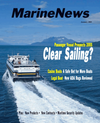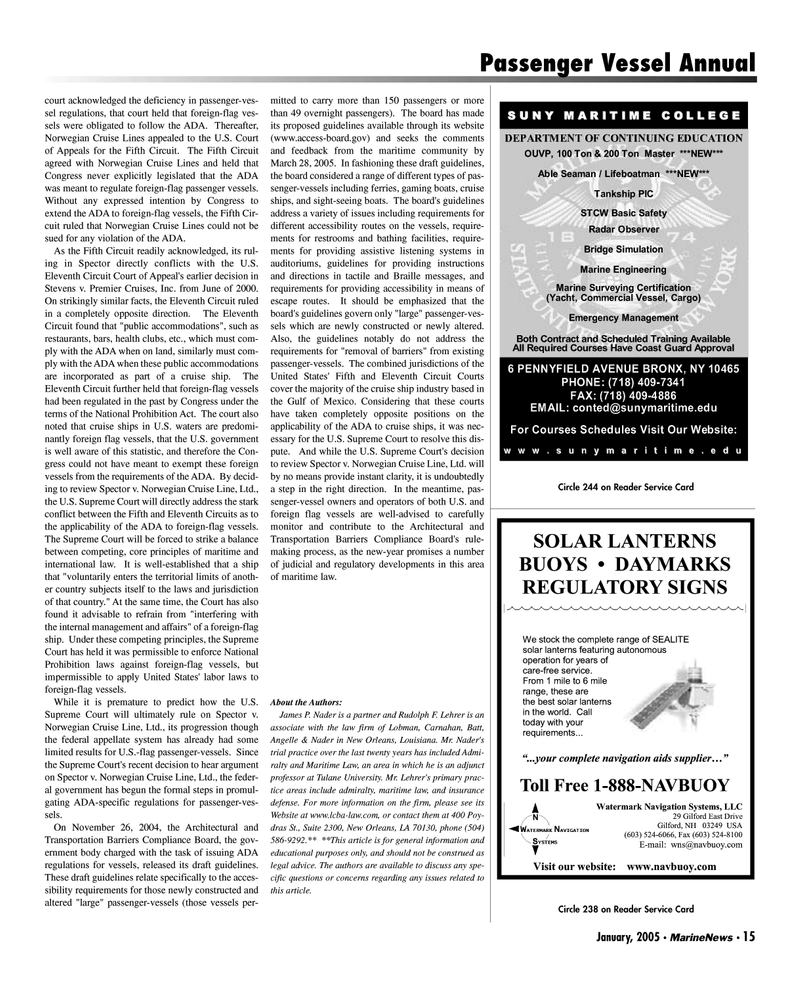
Page 15: of Marine News Magazine (January 2005)
Read this page in Pdf, Flash or Html5 edition of January 2005 Marine News Magazine
January, 2005 • MarineNews 15
Passenger Vessel Annual court acknowledged the deficiency in passenger-ves- sel regulations, that court held that foreign-flag ves- sels were obligated to follow the ADA. Thereafter,
Norwegian Cruise Lines appealed to the U.S. Court of Appeals for the Fifth Circuit. The Fifth Circuit agreed with Norwegian Cruise Lines and held that
Congress never explicitly legislated that the ADA was meant to regulate foreign-flag passenger vessels.
Without any expressed intention by Congress to extend the ADA to foreign-flag vessels, the Fifth Cir- cuit ruled that Norwegian Cruise Lines could not be sued for any violation of the ADA.
As the Fifth Circuit readily acknowledged, its rul- ing in Spector directly conflicts with the U.S.
Eleventh Circuit Court of Appeal's earlier decision in
Stevens v. Premier Cruises, Inc. from June of 2000.
On strikingly similar facts, the Eleventh Circuit ruled in a completely opposite direction. The Eleventh
Circuit found that "public accommodations", such as restaurants, bars, health clubs, etc., which must com- ply with the ADA when on land, similarly must com- ply with the ADA when these public accommodations are incorporated as part of a cruise ship. The
Eleventh Circuit further held that foreign-flag vessels had been regulated in the past by Congress under the terms of the National Prohibition Act. The court also noted that cruise ships in U.S. waters are predomi- nantly foreign flag vessels, that the U.S. government is well aware of this statistic, and therefore the Con- gress could not have meant to exempt these foreign vessels from the requirements of the ADA. By decid- ing to review Spector v. Norwegian Cruise Line, Ltd., the U.S. Supreme Court will directly address the stark conflict between the Fifth and Eleventh Circuits as to the applicability of the ADA to foreign-flag vessels.
The Supreme Court will be forced to strike a balance between competing, core principles of maritime and international law. It is well-established that a ship that "voluntarily enters the territorial limits of anoth- er country subjects itself to the laws and jurisdiction of that country." At the same time, the Court has also found it advisable to refrain from "interfering with the internal management and affairs" of a foreign-flag ship. Under these competing principles, the Supreme
Court has held it was permissible to enforce National
Prohibition laws against foreign-flag vessels, but impermissible to apply United States' labor laws to foreign-flag vessels.
While it is premature to predict how the U.S.
Supreme Court will ultimately rule on Spector v.
Norwegian Cruise Line, Ltd., its progression though the federal appellate system has already had some limited results for U.S.-flag passenger-vessels. Since the Supreme Court's recent decision to hear argument on Spector v. Norwegian Cruise Line, Ltd., the feder- al government has begun the formal steps in promul- gating ADA-specific regulations for passenger-ves- sels.
On November 26, 2004, the Architectural and
Transportation Barriers Compliance Board, the gov- ernment body charged with the task of issuing ADA regulations for vessels, released its draft guidelines.
These draft guidelines relate specifically to the acces- sibility requirements for those newly constructed and altered "large" passenger-vessels (those vessels per- mitted to carry more than 150 passengers or more than 49 overnight passengers). The board has made its proposed guidelines available through its website (www.access-board.gov) and seeks the comments and feedback from the maritime community by
March 28, 2005. In fashioning these draft guidelines, the board considered a range of different types of pas- senger-vessels including ferries, gaming boats, cruise ships, and sight-seeing boats. The board's guidelines address a variety of issues including requirements for different accessibility routes on the vessels, require- ments for restrooms and bathing facilities, require- ments for providing assistive listening systems in auditoriums, guidelines for providing instructions and directions in tactile and Braille messages, and requirements for providing accessibility in means of escape routes. It should be emphasized that the board's guidelines govern only "large" passenger-ves- sels which are newly constructed or newly altered.
Also, the guidelines notably do not address the requirements for "removal of barriers" from existing passenger-vessels. The combined jurisdictions of the
United States' Fifth and Eleventh Circuit Courts cover the majority of the cruise ship industry based in the Gulf of Mexico. Considering that these courts have taken completely opposite positions on the applicability of the ADA to cruise ships, it was nec- essary for the U.S. Supreme Court to resolve this dis- pute. And while the U.S. Supreme Court's decision to review Spector v. Norwegian Cruise Line, Ltd. will by no means provide instant clarity, it is undoubtedly a step in the right direction. In the meantime, pas- senger-vessel owners and operators of both U.S. and foreign flag vessels are well-advised to carefully monitor and contribute to the Architectural and
Transportation Barriers Compliance Board's rule- making process, as the new-year promises a number of judicial and regulatory developments in this area of maritime law.
About the Authors:
James P. Nader is a partner and Rudolph F. Lehrer is an associate with the law firm of Lobman, Carnahan, Batt,
Angelle & Nader in New Orleans, Louisiana. Mr. Nader's trial practice over the last twenty years has included Admi- ralty and Maritime Law, an area in which he is an adjunct professor at Tulane University. Mr. Lehrer's primary prac- tice areas include admiralty, maritime law, and insurance defense. For more information on the firm, please see its
Website at www.lcba-law.com, or contact them at 400 Poy- dras St., Suite 2300, New Orleans, LA 70130, phone (504) 586-9292.** **This article is for general information and educational purposes only, and should not be construed as legal advice. The authors are available to discuss any spe- cific questions or concerns regarding any issues related to this article.
Watermark Navigation Systems, LLC 29 Gilford East Drive
Gilford, NH 03249 USA (603) 524-6066, Fax (603) 524-8100
E-mail: [email protected]
Toll Free 1-888-NAVBUOY
Visit our website: www.navbuoy.com
SOLAR LANTERNS
BUOYS • DAYMARKS
REGULATORY SIGNS
We stock the complete range of SEALITE solar lanterns featuring autonomous operation for years of care-free service.
From 1 mile to 6 mile range, these are the best solar lanterns in the world. Call today with your requirements... “...your complete navigation aids supplier…”
Circle 238 on Reader Service Card
Circle 244 on Reader Service Card
S U N Y M A R I T I M E C O L L E G E
S U N Y I T I E C L E G E R M C
OUVP, 100 Ton & 200 Ton Master ***NEW***
Able Seaman / Lifeboatman ***NEW***
Tankship PIC
STCW Basic Safety
Radar Observer
Bridge Simulation
Marine Engineering
Marine Surveying Certification (Yacht, Commercial Vessel, Cargo)
Emergency Management
Both Contract and Scheduled Training Available
All Required Courses Have Coast Guard Approval www.sunymaritime.ed ww ari ed u 6 PENNYFIELD AVENUE BRONX, NY 10465
PHONE: (718) 409-7341
FAX: (718) 409-4886
EMAIL: [email protected]
For Courses Schedules Visit Our Website:
DEPARTMENT OF CONTINUING EDUCATION CONT NG UCRT NG E
MN JAN05 1 (1-16).qxd 1/4/2005 4:35 PM Page 15

 14
14

 16
16
